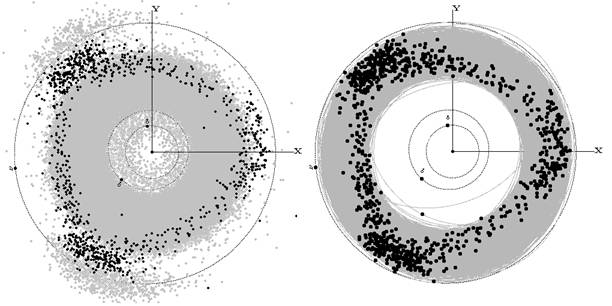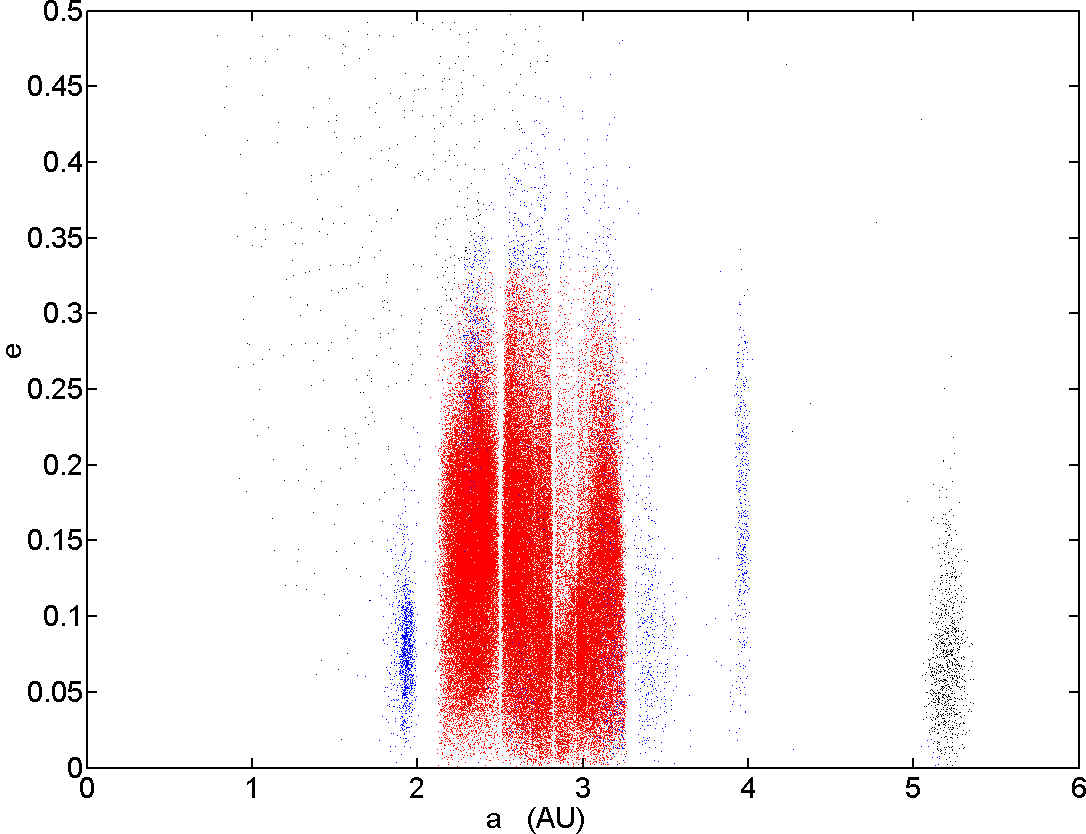|
Palomar–Leiden Survey
The Palomar–Leiden survey (PLS) was a successful astronomical survey to study faint minor planets in a collaboration between the U.S Palomar Observatory and the Dutch Leiden Observatory, and resulted in the discovery of thousands of asteroids, including many Jupiter trojans. The original PLS-survey took place in 1960, and was followed by three Palomar–Leiden Trojan survey campaigns, launched in 1971, 1973 and 1977. Its principal investigators were the astronomers Ingrid and Cornelis van Houten at Leiden and Tom Gehrels at Palomar. For the period of the entire survey (1960–1977), the trio of astronomers are credited with the discovery of 4,637 numbered minor planets, which received their own provisional designation, such as 6344 P-L, 4835 T-1 and 3181 T-2. PLS was one of the most productive minor planet surveys ever conducted: five new asteroid families were discovered, gaps at 1:3 and 2:5 orbital resonances with Jupiter were revealed, and hundreds of photographic plates ... [...More Info...] [...Related Items...] OR: [Wikipedia] [Google] [Baidu] |
Minor Planet
According to the International Astronomical Union (IAU), a minor planet is an astronomical object in direct orbit around the Sun that is exclusively classified as neither a planet nor a comet. Before 2006, the IAU officially used the term ''minor planet'', but that year's meeting reclassified minor planets and comets into dwarf planets and small Solar System bodies (SSSBs).Press release, IAU 2006 General Assembly: Result of the IAU Resolution votes International Astronomical Union, August 24, 2006. Accessed May 5, 2008. Minor planets include asteroids ( |
Photographic Plate
Photographic plates preceded photographic film as a capture medium in photography, and were still used in some communities up until the late 20th century. The light-sensitive emulsion of silver salts was coated on a glass plate, typically thinner than common window glass. History Glass plates were far superior to film for research-quality imaging because they were stable and less likely to bend or distort, especially in large-format frames for wide-field imaging. Early plates used the wet collodion process. The wet plate process was replaced late in the 19th century by gelatin dry plates. A view camera nicknamed "The Mammoth" weighing was built by George R. Lawrence in 1899, specifically to photograph "The Alton Limited" train owned by the Chicago & Alton Railway. It took photographs on glass plates measuring × . Glass plate photographic material largely faded from the consumer market in the early years of the 20th century, as more convenient and less fragile fil ... [...More Info...] [...Related Items...] OR: [Wikipedia] [Google] [Baidu] |
Survey Designation
Provisional designation in astronomy is the naming convention applied to astronomical objects immediately following their discovery. The provisional designation is usually superseded by a permanent designation once a reliable orbit has been calculated. Approximately 47% of the more than 1,100,000 known minor planets remain provisionally designated, as hundreds of thousands have been discovered in the last two decades. __TOC__ Minor planets The current system of provisional designation of minor planets (asteroids, centaurs and trans-Neptunian objects) has been in place since 1925. It superseded several previous conventions, each of which was in turn rendered obsolete by the increasing numbers of minor planet discoveries. A modern or new-style provisional designation consists of the year of discovery, followed by two letters and, possibly, a suffixed number. New-style provisional designation For example, the provisional designation stands for the 3910th body identified dur ... [...More Info...] [...Related Items...] OR: [Wikipedia] [Google] [Baidu] |
20936 Nemrut Dagi
20936 Nemrut Dagi, ''provisional designation'': , is a stony Hungaria asteroid and Mars-grazer from the innermost regions of the asteroid belt, approximately in diameter. It was discovered on 13 May 1971, by Dutch astronomer couple Ingrid and Cornelis van Houten at Leiden, on photographic plates taken by Dutch–American astronomer Tom Gehrels at Palomar Observatory in California, United States. The asteroid has a rotation period of 3.28 hours, a likely spheroidal shape, and a high albedo typically seen among the enstatite-rich E-type asteroids. In 2012, it was named after the a dormant volcano Nemrut (Nemrut Dağı) in Turkey. Orbit and classification ''Nemrut Dagi'' belongs to the dynamical group of Hungaria asteroids, which form the innermost dense concentration of asteroids in the Solar System. It orbits the Sun in the inner main-belt at a distance of 1.7–2.0 AU once every 2 years and 6 months (922 days; semi-major axis of 1.85 AU). Its orbit has an eccentric ... [...More Info...] [...Related Items...] OR: [Wikipedia] [Google] [Baidu] |
Jupiter Trojan
The Jupiter trojans, commonly called trojan asteroids or simply trojans, are a large group of asteroids that share the planet Jupiter's orbit around the Sun. Relative to Jupiter, each trojan librates around one of Jupiter's stable Lagrange points: either ', existing 60° ahead of the planet in its orbit, or ', 60° behind. Jupiter trojans are distributed in two elongated, curved regions around these Lagrangian points with an average semi-major axis of about 5.2 AU. The first Jupiter trojan discovered, 588 Achilles, was spotted in 1906 by German astronomer Max Wolf. More than 9,800 Jupiter trojans have been found . By convention, they are each named from Greek mythology after a figure of the Trojan War, hence the name "trojan". The total number of Jupiter trojans larger than 1 km in diameter is believed to be about , approximately equal to the number of asteroids larger than 1 km in the asteroid belt. Like main-belt asteroids, Jupiter trojans form families. , man ... [...More Info...] [...Related Items...] OR: [Wikipedia] [Google] [Baidu] |
Asteroid Belt
The asteroid belt is a torus-shaped region in the Solar System, located roughly between the orbits of the planets Jupiter and Mars. It contains a great many solid, irregularly shaped bodies, of many sizes, but much smaller than planets, called asteroids or minor planets. This asteroid belt is also called the main asteroid belt or main belt to distinguish it from other asteroid populations in the Solar System such as near-Earth asteroids and trojan asteroids. The asteroid belt is the smallest and innermost known circumstellar disc in the Solar System. About 60% of its mass is contained in the four largest asteroids: Ceres, Vesta, Pallas, and Hygiea. The total mass of the asteroid belt is calculated to be 3% that of the Moon. Ceres, the only object in the asteroid belt large enough to be a dwarf planet, is about 950 km in diameter, whereas Vesta, Pallas, and Hygiea have mean diameters less than 600 km. The remaining bodies range down to the size of a dust particle. ... [...More Info...] [...Related Items...] OR: [Wikipedia] [Google] [Baidu] |
Hilda Family
The Hilda asteroids (adj. ''Hildian'') are a dynamical group of more than 5,000 asteroids located beyond the asteroid belt but within Jupiter's orbit, in a 3:2 orbital resonance with Jupiter. The namesake is the asteroid 153 Hilda. Hildas move in their elliptical orbits in such a fashion that they arrive closest to Jupiter's orbit (i.e. at their aphelion) just when either one of Jupiter's , or Lagrange points arrives there. On their next orbit their aphelion will synchronize with the next Lagrange point in the –– sequence. Since , and are 120° apart, by the time a Hilda completes an orbit, Jupiter will have completed 360° − 120° or two-thirds of its own orbit. A Hilda's orbit has a semi-major axis between 3.7 and 4.2 AU (the average over a long time span is 3.97), an eccentricity less than 0.3, and an inclination less than 20°. Two collisional families exist within the Hilda group: the Hilda family and the Schubart family. The namesake for the latter fa ... [...More Info...] [...Related Items...] OR: [Wikipedia] [Google] [Baidu] |
Hungaria Family
The Hungaria asteroids, also known as the Hungaria group, are a dynamical group of asteroids in the asteroid belt which orbit the Sun with a semi-major axis (longest radius of an ellipse) between 1.78 and 2.00 astronomical units (AU). They are the innermost dense concentration of asteroids in the Solar System—the near-Earth asteroids are much more sparse—and derive their name from their largest member 434 Hungaria. The Hungaria group includes the Hungaria family (), a collisional asteroid family which dominates its population. Description The Hungaria asteroids typically share the following orbital parameters: * Semi-major axis between 1.78 and 2.00 AU * Orbital period of approximately 2.5 years * Low eccentricity of below 0.18 * An inclination of 16° to 34° * Approximate mean-motion resonance with Jupiter of 9:2, and with Mars of 2:3 The 4:1 resonance Kirkwood gap (at 2.06 AU) marks the outer boundary of the Hungaria family, while interactions with Mars determine ... [...More Info...] [...Related Items...] OR: [Wikipedia] [Google] [Baidu] |
Solar System
The Solar SystemCapitalization of the name varies. The International Astronomical Union, the authoritative body regarding astronomical nomenclature, specifies capitalizing the names of all individual astronomical objects but uses mixed "Solar System" and "solar system" structures in theinaming guidelines document. The name is commonly rendered in lower case ('solar system'), as, for example, in the ''Oxford English Dictionary'' an''Merriam-Webster's 11th Collegiate Dictionary''. is the gravity, gravitationally bound system of the Sun and the objects that orbit it. It Formation and evolution of the Solar System, formed 4.6 billion years ago from the gravitational collapse of a giant interstellar molecular cloud. The solar mass, vast majority (99.86%) of the system's mass is in the Sun, with most of the Jupiter mass, remaining mass contained in the planet Jupiter. The four inner Solar System, inner system planets—Mercury (planet), Mercury, Venus, Earth and Mars—are terrest ... [...More Info...] [...Related Items...] OR: [Wikipedia] [Google] [Baidu] |
Minor Planet Designation
A formal minor-planet designation is, in its final form, a number–name combination given to a minor planet (asteroid, centaur, trans-Neptunian object and dwarf planet but not comet). Such designation always features a leading number (catalog or IAU number) assigned to a body once its orbital path is sufficiently secured (so-called "numbering"). The formal designation is based on the minor planet's provisional designation, which was previously assigned automatically when it had been observed for the first time. Later on, the provisional part of the formal designation may be replaced with a name (so-called "naming"). Both formal and provisional designations are overseen by the Minor Planet Center (MPC), a branch of the International Astronomical Union. Currently, a number is assigned only after the orbit has been secured by four well-observed oppositions. For unusual objects, such as near-Earth asteroids, numbering might already occur after three, maybe even only two, opposition ... [...More Info...] [...Related Items...] OR: [Wikipedia] [Google] [Baidu] |
Minor Planet Center
The Minor Planet Center (MPC) is the official body for observing and reporting on minor planets under the auspices of the International Astronomical Union (IAU). Founded in 1947, it operates at the Smithsonian Astrophysical Observatory. Function The Minor Planet Center is the official worldwide organization in charge of collecting observational data for minor planets (such as asteroids), calculating their orbits and publishing this information via the '' Minor Planet Circulars''. Under the auspices of the International Astronomical Union (IAU), it operates at the Smithsonian Astrophysical Observatory, which is part of the Center for Astrophysics along with the Harvard College Observatory. The MPC runs a number of free online services for observers to assist them in observing minor planets and comets. The complete catalogue of minor planet orbits (sometimes referred to as the "Minor Planet Catalogue") may also be freely downloaded. In addition to astrometric data, the MPC collect ... [...More Info...] [...Related Items...] OR: [Wikipedia] [Google] [Baidu] |





